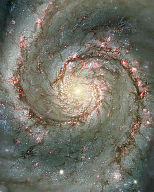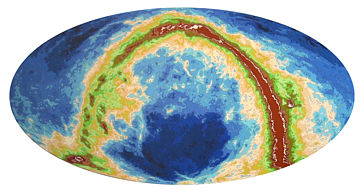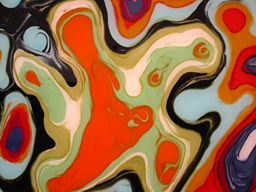Macrocosm - the science behind the imagesEye in the Sky: Enhanced Vision: Seeing to the Origin: Mapping the Data: Chaos: (see also: Simulations: the science behind the images)This series uses images from science. I am fascinated with the striking visual data that is being produced as scientists examine the universe for signs of structure at the largest and smallest scales. Orbiting scientific observatories such as the Hubble space telescope, COBE, YOHKOH, and others are providing visions of the broader universe with unprecedented clarity. At the same time, theoretical physicists are engaged in a project to understand the smallest scales imaginable, where the fundamental forces unite into a unified theory. As the energies required to probe these minute scales are (for now, at least) unattainable, these new theories are judged in large part by criteria of elegance and beauty. |
|
Eye in the Sky:All of the images in this show are seen from a perspective in space. None of the images I am working from could not be seen by the unaided eye (an interesting exception is the painting Hurricane, which is based on an ordinary photograph taken by an Apollo astronaut in orbit around the earth). Instruments can detect frequencies the eye can't see. The YOHKOH and TRACE instruments aimed at the sun reveal its complex, dynamic structure in UV light.
|
Jonathan Feldschuh, Hurricane, acrylic on canvas over panel, 78" x 72", 2001 |
|
TRACE satellite image |
YOHKOH satellite image 12/30/2001 |
Enhanced Vision:Multiple observations can be combined, superimposed, and processed in ways that expand our "vision". Many of the stunning Hubble images use color-coding to incorporate information from different wavelengths into a single image. In this image of the whirlpool galaxy, young stars have been color-coded in red by superimposing Hubble measurements of hydrogen emissions onto ground-based images.
|
|
Seeing to the Origin:A number of paintings in this series are based on the COBE (Cosmic Orbital Background Explorer) project. The aim of the project was to study the background radiation which pervades the entire universe, the echo of the Big Bang. After a multi-year survey, the result was a series of images: pictures of the entire universe, and even more remarkable, pictures of the structure of the early universe, fractions of a second old. |
Jonathan Feldschuh, Universe (DIRBE 100 micron data), acrylic on canvas over panel, 24" x 48", 2001
|
|
Because most of the images that I am using were originally made with non-visible frequencies, the colors in which they were first published are somewhat arbitrary. In making the paintings, I allowed myself the freedom of creating color schemes other than the conventional ones typically used for presenting scientific imagery (such as the blue/red cold/hot spectrum used here).
The original spectrum
The spectrum used for the painting Note that although the second spectrum may seem arbitrary or perverse, it is still a valid presentation of the underlying data - it might reveal structure or pattern that is not as apparent in the original.
In the painting Island Universe, I substituted a deep sea-shallow sea-beach-forest-mountain spectrum (such as a mapmaker might use to show elevation) for the original NASA thermal spectrum to create an image that suggests the entire universe as a coral atoll in the Pacific.
|
Cosmic Microwave Background as presented by NASA Jonathan Feldschuh, Cosmic Microwave Background, acrylic on canvas over panel, 24" x 48", 2001
Jonathan Feldschuh, Island Universe (DIRBE 100 micron data), acrylic on canvas over panel, 48" x 96", 2002
|
Chaos:When I choose to translate a dataset into a painting (as opposed to a digital representation of the data) I am adding noise to the signal. The nature of this noise is what drives my interest in these images as an artist. I allow the material qualities of liquid paint to play out in the image, and I accentuate some of the swirling, mixing effects that result with colored pencil lines. What attracts me to this approach is the chaotic nature of the phenomena I am depicting - swirling, expanding plasma and gas. I use the idea of fractal similarity to connect similar patterns across vast changes of scale - from the microcosmic to the macrocosmic.
detail of Solar Flares (TRACE data) #1 |
detail of Cosmic Microwave Background
detail of Hurricane
|
| - Jonathan Feldschuh | |
| Look at more
statements |
|








 1_detail2.lr.jpg)

